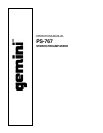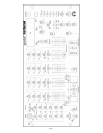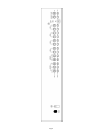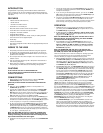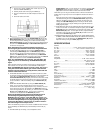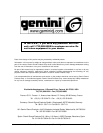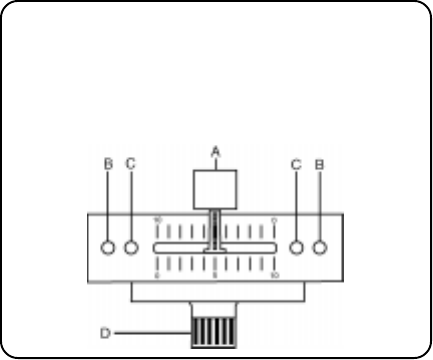
Page 4
1. Unscrew the outside FADER plate screws (B). Do not
touch the INSIDE SCREWS (C).
2. Carefully lift the fader and unplug the CABLE (D).
3. Plug the new fader into the cable and place it back in the
mixer.
4. Screw the fader to the mixer.
6. BEAT INDICATORS: Each side of the CROSSFADER (38) has its own
BEAT INDICATOR 42, 44). They flash at the low frequency peak level
of each assigned source, allowing you to match the beats visually.
BEAT INDICATOR (42) will reflect the beat of the source assigned to the
left side of the CROSSFADER (38) and BEAT INDICATOR (44) will do
the same for the right side.
Note: The flashing level can be fine tuned by increasing or
decreasing the gain and bass controls of the assigned channel.
7. OUTPUT CONTROL SECTION: The level of the AMP OUT (66) is
controlled by the MASTER (33) slide. The BALANCE (34) control will
allow the Amp Out signal to be balanced between the left and right
speakers. The MONO (35) switch, when depressed, (the MONO LED
(36) will glow), will make the Amp Out signal a mono signal. The BOOTH
(37) control adjusts the level of the BOOTH OUTPUT (68).
Note: The LED DISPLAY (48) indicates the AMP OUT (66)
signal only and is not affected by the BOOTH OUTPUT (68)
signal.
HINT: The booth OUTPUT is used by some DJs to run monitor speakers in
their DJ booth. You can also use it as a second ZONE or AMP output.
Note: The RECORD OUT (67) has no level control. The level is
set by the channel slides and the gain control of the selected
channel. The tonal qualities are set by the bass, treble and mid
controls of that same channel.
8. TALKOVER SECTION: The purpose of the talkover section is to allow
the program playing to be muted so that the mic can be heard above the
music. When the TALKOVER ON/OFF (45) button is pushed (the
TALKOVER INDICATOR (46) will glow), the volume of all sources except
the DJ Mic and the Aux channel are reduced. The amount of reduction
can be set between -6 dB and -36 dB by using the MUTE LEVEL (47)
control.
9. SEND AND RECEIVE SECTION: By using the SEND ASSIGN (49)
switch, you can send the selected signal to some sort of audio
enhancement device (like a digital sampler or key controller). The level
of the signal being sent can be adjusted by the SEND (50) control. To
receive the signal back into the PS-767, you must first turn on the RCV
ON (51) switch (LED (52) will light). The level of the signal being
received can be adjusted with the RECEIVE (53) control.
Note: The signal being received back into the PS-767 can be
monitored by using the headphones and by pressing the
RECEIVE (54) cue control. If the RCV ON (51) switch is in
the off position (LED (52) is off), the level of the signal can be
monitored and adjusted prior to its playing through the output.
Turning the RCV ON (51) switch to the on position connects
the received signal to the output section.
HINT: The RECEIVE (81) input can be used as an additional stereo line level
input controlled by the RECEIVE (53) and activated by the RCV ON (51)
switch.
10. CUE SECTION: By connecting a set of headphones to the
HEADPHONE (4) jack, you can monitor any or all of the channels. CUE
ASSIGN (55) buttons are for the channels 1 - 4 and the CUE ASSIGN
(56) button is for the Aux Mic/Line Mono channel and the DJ Mic.
HINT: When you are using the DJ Mic and have a device connected to the
DJ Mic Loop, the signal you hear in the headphones includes the device in
the loop.
Select the correct Cue assign button or buttons and their respective
LED indicators will glow. Use the HEADPHONE LEVEL (57) control to
adjust the headphone volume with out effecting the overall mix. By
rotating the CUE PGM PAN (58) control to the left you will be able to
monitor the assigned cue signal. Rotating to the right will monitor the
PGM (program) output.
11. ECHO SECTION: Echo can be applied to either the microphones or the
music but not to both. To select the microphone option, press the MIC
ECHO (59) button (the LED will glow). To select the music option use the
MUSIC ECHO (60) button. You can adjust the level, repeat and delay
parameters of the echo by using the ECHO (62) controls.To turn echo
off, push the OFF ECHO (61) button.
12. DRUM EFFECTS SECTION: Six different drum effects (BASS DRUM,
CYMBAL, LASER DRUM, SNARE DRUM, HI CONGA and CLAPS) may
be added to your mix by depressing the DRUM EFFECT (63) buttons.
Adjust the level by turning the LEVEL (64) control.
SPECIFICATIONS
INPUTS:
DJ Mic.......................................1.5mV 3Kohm balanced/unbalanced
Aux Mic..............................................1.5mV 10Kohm unbalanced only
Aux Line...................................................................150mV 27Kohm
DJ Loop............................................................................150mV 10Kohm
Phono............................................................................3mV 47Kohm
Line................................................................................150 mV 27Kohm
Receive...........................................................................75mV 27Kohm
OUTPUTS:
Amp/Booth...........................................................0 dB 775mV 400ohm
Max...............................................24V Peak to Peak
Rec.............................................................................225mV 5Kohm
DJ Loop.......................................................................150mV 220ohm
Send..................................................................................150 mV 300ohm
GENERAL:
Bass.............................................................................................+/- 12dB
Mid.................................................................................................+/- 9dB
Treble...........................................................................................+/- 12dB
Echo.......................................................................................600msec
Gain (Mic/Aux)............................................................................0 to -40dB
Gain (Chnls 1-4)........................................................................0 to -20dB
Frequency Response........................................20Hz - 20KHz +/- 2dB
Distortion.....................................................................................0.02%
S/N Ratio......................................................................better than 80dB
Talkover Attenuation............................................................-6 to -36dB
Headphone Impedance................................................................16ohm
Power Source.......................................................115/230V 50/60Hz 15W
Dimensions...................................................482mm x 240mm x 110mm
19" x 9 1/2" x 4 1/4"
Weight.............................................................................11lbs (5Kg)



